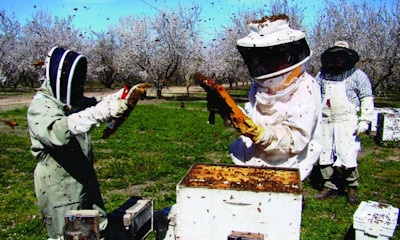May 17, 2016

Universities are well known for their in-depth publications on a wide range of topics. Extension agriculture educators produce a wealth of information, but a lot of it can be difficult to access when you're away from the farm office. At Oregon State University, extension experts have taken that information to heart and created a smart phone app built on a popular bee-focused publication.
Ramesh Sagili, an OSU entomologist and bee researcher notes: "It's a smart phone world. Our stakeholders have been asking for an app to go along with this publication, and they're very excited we now have one."

PROTECTING POLLINATORS: Beekeepers inspect their colonies in a California almond orchard. Oregon State University has launched a new app that offers quick access to key information about pesticide use around bees. Photo by Louisa Hooven.
How to Reduce Bee Poisoning from Pesticides was first published in 2006 and expanded in 2013 by coauthor Louisa Hooven, a toxicologist and bee expert in the College Agricultural Sciences, with an extensive update of the pesticide information. The app provides ready access to information originally available only through the guide.
Products in the app are sorted into three classes - highly toxic, toxic and "no bee precautionary statement on label." Ratings are base on the cautions and restrictions required by the Environmental Protection Agency and listed on product labels, Hooven says.
The guide also estimates "residual toxicity" for several of the products - or how long their effects persist in the environment. That information, not required by EPA, and may not be on the product label, came from Hooven's search through EPA risk assessment documents and the toxicology literature.
The guide recommends best practices for managing pesticide applications to protect all bee species—not only honey bees (Apis mellifera), but mason bees (Osmia lignaria), alkali bees (Nomia melanderi) and alfalfa leafcutting bees (Megachile rotundata). These bee species are also managed as agricultural pollinators. And it tells how to protect native ground-dwelling species including squash bees, long-horned bees, sweat bees, mining bees and bumblebees.
Adds Hooven: "Pesticides will affect these species differently than honey bees or other managed species, because they have different life habits and are present at different times."
Sagili notes that West Coast agriculture is critically dependent on pollinating insects. He has authored or coauthored four other Extension publications on honey bees. "Crops in the Midwest, such as corn and soybeans, don't require insects for pollination," he says. "But with our diversity of crops, especially our fruit trees, berries and seed crops, we really need them."
You can download the new apps to your specific smart phone using the links below:
iOS - Apple devices - use this link.
Android devices - go to this link.
Source: Oregon State University
You May Also Like




